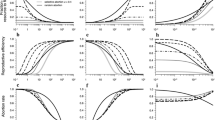Abstract
Competition between seeds within a fruit for parental resources is described using one-locus-two-allele models. While a “normal” allele leads to an equitable distribution of resources between seeds (a situation which also corresponds to the parental optimum), the “selfish” allele is assumed to cause the seed carrying it to usurp a higher proportion of the resources. The outcome of competition between “selfish” alleles is also assumed to lead to an asymmetric distribution of resources, the “winner” being chosen randomly. Conditions for the spread of an initially rare selfish allele and the optimal resource allocation corresponding to the evolutionarily stable strategy, derived for species with n-seeded fruits, are in accordance with expectations based on Hamilton’s inclusive fitness criteria. Competition between seeds is seen to be most intense when there are only two seeds, and decreases with increasing number of seeds, suggesting that two-seeded fruits would be rarer than one-seeded or many-seeded ones. Available data from a large number of plant species are consistent with this prediction of the model.
Similar content being viewed by others
References
Ganeshaiah K. N. and Uma Shaanker R. 1988 Regulation of seed number and female incitation of mate competition by a pH-dependent proteinaceous inhibitor of pollen grain germination inLeucaena leucocephala.Oecologial 75: 110–113
Ganeshaiah K. N., Uma Shaanker R. and Joshi N. V. 1991 Evolution of polyembryony: Consequences to the fitness of mother and offspring.J. Genet. 70: 103–127
Haig D. and Westoby M. 1988 Inclusive fitness, seed resources, and maternal care. InPlant reproductive ecology (eds) Jon Lovett Doust and Lesley Lovett Doust (New York: Oxford University Press) pp. 60–79
Haig D. and Westoby M. 1991 Genomic imprinting in endosperm: its effect on seed development in crosses between species, and between different ploidies of the same species, and its implications for the evolution of apomixis.Phil. Trans. R. Soc. London B333: 1–13
Haldane J. B. S. 1924 A mathematical theory of natural and artificial selection. Part I.Trans. Cambridge Philos. Soc. 23: 19–41
Hamilton W. D. 1964 The genetical evolution of social behaviour, I.J. Theor. Biol. 7: 1–16
Hamilton W. D. 1964 The genetical evolution of social behaviour, II.J. Theor. Biol. 7: 17–52
Kress W. J. 1981 Sibling competition and evolution of pollen unit, ovule number and pollen vector in angiosperms.Syst. Bot. 6: 101–112
Law R. and Cannings C. 1984 Genetic analysis of conflicts arising during development of seeds in the Angiospermophyta.Proc. R. Soc. London B221: 53–70
Lee T. D. 1988 Patterns of fruit and seed production. InPlant reproductive ecology (eds) Jon Lovett Doust and Lesley Lovett Doust (New York: Oxford University Press) pp. 179–202
Lovett Doust J. and Lovett Doust L. 1988 Sociobiology of plants: an emerging synthesis. InPlant reproductive ecology (eds) Jon Lovett Doust and Lesley Lovett Doust (New York: Oxford University Press) pp. 5–29
Macnair M. R. and Parker G. A. 1979 Models of parent-offspring conflict. III. Intra-brood conflict.Anim. Behav. 27: 1202–1209
Nakamura R. R. 1980 Plant kin selection.Evol. Theory 5: 113–117
Nakamura R. R. 1986 Maternal investment and fruit abortion inPhaseolus vulgaris.Am. J. Bot. 73: 1049–1057
O’Connor R. J. 1978 Brood reduction in birds: selection for fratricide, infanticide and suicide.Anim. Behav. 26: 79–96
Queller D. C. 1983 Kin selection and conflict in seed maturation.J. Theor. Biol. 100: 153–172
Smith C. C. and Fretwell S. D. 1974 The optimal balance between size and number of offspring.Am. Nat. 108: 499–506
Stinson C. H. 1979 On the selective advantage of fratricide in raptors.Evolution 33: 1219–1225
Sutter J. 1969 Haldane and demographic genetics. InHaldane and modern biology (ed) K. R. Dronamraju (Baltimore: The Johns Hopkins Press) pp. 73–77
Uma Shaanker R. and Ganeshaiah K. N. 1988 Bimodal distribution of seeds per pod inCaesalpinia pulcherrima: parent-offspring conflict?Evol. Trends Plants 2: 91–98
Uma Shaanker R., Ganeshaiah K. N. and Bawa K. S. 1988 Parent-offspring conflict, sibling rivalry, and brood reduction in plants.Annu. Rev. Ecol. Syst. 14: 177–205
Uma Shaanker R., Ganeshaiah, K. N. and Radhamani T. R. 1990 Associations among the modes of pollination and seed dispersal — ecological factors and phylogenetic constraints.Evol. Trends Plants 4: 107–111
Westoby M. and Rice B. 1982 Evolution of seed plants and inclusive fitness of plant tissues.Evolution 36: 713–724
Wiens D. 1984 Ovule survivorship, brood size, life history, breeding systems and reproduction success in plants.Oecologia 64: 47–53
Wiens D., Calvin C. L., Wilson C. A., Davern C. I., Frank D. and Seavey S. R. 1987 Reproductive success, spontaneous embryo abortion and genetic load in flowering plants.Oecologia 71: 501–509
Author information
Authors and Affiliations
Additional information
Based on a talk given at the Haldane Centenary Symposium held on 6 November 1992 at Ahmedabad as part of the 58th Annual Meeting of the Indian Academy of Sciences.
Rights and permissions
About this article
Cite this article
Joshi, N.V. Sibling rivalry between seeds within a fruit: Some population genetic models. J. Genet. 71, 105–119 (1992). https://doi.org/10.1007/BF02927891
Received:
Issue Date:
DOI: https://doi.org/10.1007/BF02927891




